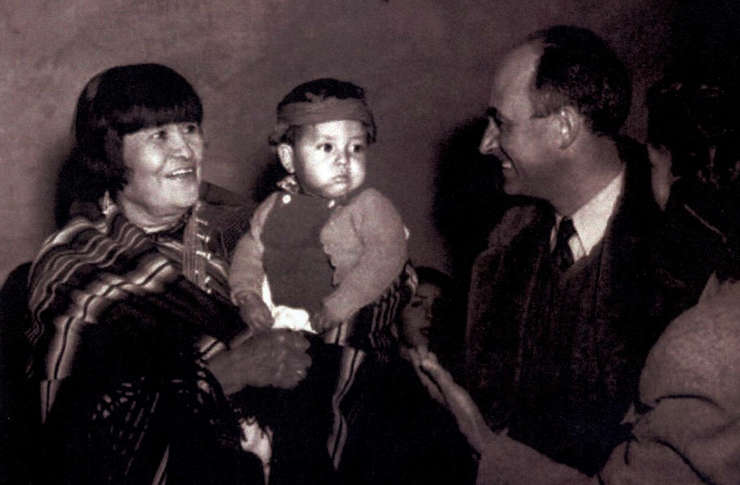Maria Martinez
San Ildefonso Pueblo

Pueblo potter Maria Martinez meeting physicist Enrico Fermi, circa 1948
Maria Montoya Martinez (1887 - July 20, 1980) was a San Ildefonso Pueblo pottery artist who created an internationally known style of pottery. Maria (born Maria Antonia Montoya), with her husband Julian and other family members, researched traditional Pueblo pottery styles and design techniques to create pieces reflective of the Pueblo people's legacy of fine artwork and crafts.
At an early age, Maria learned the basic ancient pottery skills from her aunt. At that time, Spanish tinware and Anglo enamelware had become readily available in the Southwest, reducing the need for traditional cooking and serving pots. Traditional pottery making techniques were being devalued and abandoned all across the world of the Pueblos, but Maria was doing the right thing in the right place at the right time...
Edgar Lee Hewitt was leading an archaeological expedition at the ruins of Tsankawi, part of Bandelier National Monument in New Mexico in 1908. His workers found shards of polished jet black pottery and Hewitt went looking for a potter to recreate that. He wanted to go to descendants of the Tsankawi people and that meant San Ildefonso. So he inquired after a potter who was proficient enough to be able to recreate that black pottery. Everyone he spoke to pointed at Maria as the best potter in the pueblo. So he went to Maria and worked out an arrangement where he paid her in advance for her to produce a number of black pots that were also made in styles very close to what he'd found in the dig.
Maria and Julian experimented with a number of different clays, tempering agents and firing methods but nothing was producing the results she wanted. Serafina Tafoya of Santa Clara Pueblo was still making pottery the ancient way and she showed them a method of smothering the fire at a certain point during firing that caused a vacuum induction/oxygen reduction process that trapped the smoke and essentially carbonized the clay surfaces of the pots, turning everything black. Maria also picked up several polishing and burnishing tips from Serafina.
She delivered a few black pots to Hewitt in 1913, then hid the rest away. She wasn't happy with the quality of them until Hewitt brought some guests to Maria's home several years later and they were primarily interested in her black pots. That was when she decided to perfect her process for making them. Julian also spent several years developing a process for decorating the pots in which the pot is burnished first, then a matte background added. Between her ability to make the pots and her husband Julian's ability to decorate them, Maria became world-famous and is attributed with resuscitating Pueblo pottery as an art form. Maria also spent half her life teaching others to make pottery her way.
In the early days, none of the pueblo artists ever signed their work as no one ever expected to become famous or have their name add value to their creations. Maria is attributed with the first signature on a pot, "Marie" in 1922. She had consulted with Chester Faris, Director of the Santa Fe Indian School, and Kenneth Chapman, Director of the Museum of New Mexico. They convinced her that "Marie" was a name more familiar to the Anglo buying public.
As much as her husband contributed greatly to the process, the making of pottery was not a man's thing in the pueblo so she left his name off until 1926 when the signature changed to "Marie + Julian". The signature changed again after Julian died in 1943. Maria's son Adam took over Julian's chores of gathering the clay and helping Maria fire the pots. His wife Santana helped Maria by taking over the painting as Maria almost never painted anything. Santana painted a lot of pottery during this time: those were Maria's most prolific years. The signature became "Marie + Santana" until 1956.
In 1950, Maria invited her son Popovi Da into the circle as he was a successful watercolor painter and she felt he might take over what had been his father's job in her business. Adam taught him how to collect and prepare the clay and do the firing. Santana taught him the painting techniques she'd learned from Julian. Sometime in 1956 Maria changed "Marie" to "Maria" (at Popovi's insistence) and began working with Popovi Da while Adam and Santana became established potters under their own name. In 1956 the signature on Maria's pots became "Maria Poveka" or "Maria/Popovi", depending on whether he'd painted the piece or not (Poveka was Maria's Tewa name, it means "Pond lily").
Maria traveled the world demonstrating her processes and selling her pottery. She met every man who was President during her adult years and taught many, many people how to make Pueblo pottery the traditional way. At this point in time, she is remembered as the matriarch of a seven-generation Martinez dynasty in the pottery world. And she always attributed a lot of what she knew to Serafina Tafoya of Santa Clara Pueblo, matriarch of the eight-generation Tafoya dynasty.